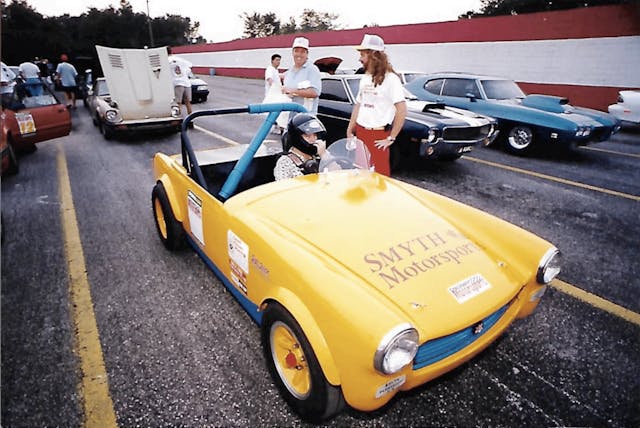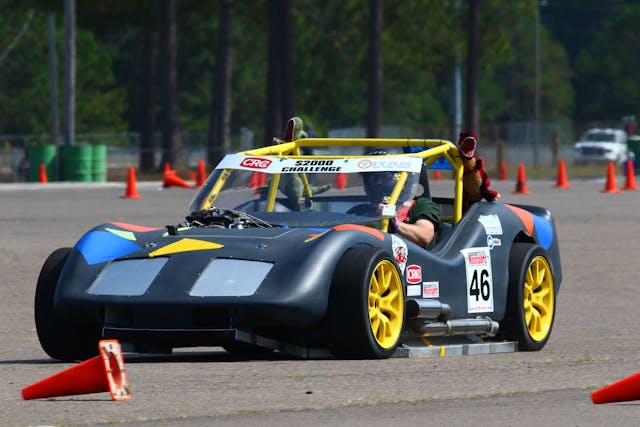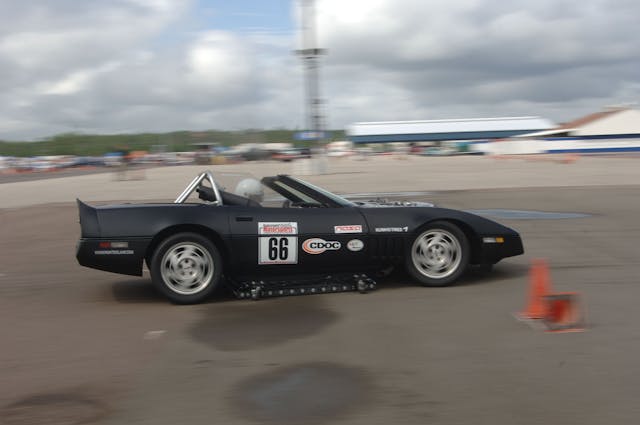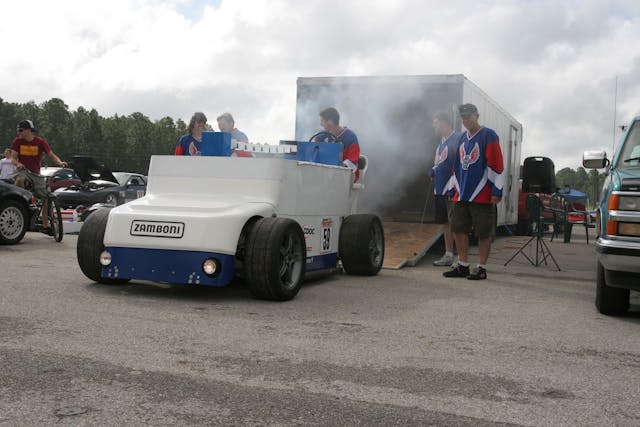$2000 Challenge: A low-budget racing bonanza
“Like most good ideas,” said Tim Suddard, founder and publisher of Grassroots Motorsports magazine, “it started with too many beers.”
Suddard and his drinking buddies had been discussing the cost of racing. The high cost of racing. Which, truth be told, really needn’t cost a fortune, Suddard surmised.
“I got so tired of hearing that it’s too expensive. I said I bet that for a couple grand you could get into something that’s competitive, safe, and fun. If you are paying somebody else to do it, no, not so much, but if you are willing to do some of the work yourself …
“That went from a drinking session idea to a ‘let’s do it’ idea.” They put the word out on the magazine message boards, but they weren’t expecting much response. Suddard and a few of his staffers built cars, “and I figured if we had just those three cars we’d have a story, because we didn’t think anybody else would show up. We ended up having 25 cars,” Suddard said. What started out as a “one-shot editorial exercise” became an annual event.
The premise for that fall, 1999 competition: Build a car for under $1500—and yes, receipts were required—that you could drag race, autocross and take through concours judging. They skipped 2000, and started the competition back up in 2001, as the $2001 Challenge. The budget and the event’s name was whatever year it was, until somebody got tired of keeping score and printing new signs, logos and tee-shirts every year, and it settled in as the $2000 Challenge.
Labor and safety equipment don’t count against the budget. And a lot of resourceful teams will buy, say, a $1000 junker just to get its $200 engine, and sell off seats and the transmission and other parts, and that helps keep the overall budget to $2000. That, and a lot of horse trading, eBay, and Craigslist shopping, and junkyard excavations.

Suddard suggests that Guido The Clown—yes, he was an actual professional clown—was among the first ones “to totally get the premise” on his way to victory. “He built an MG Midget with a Chevrolet Cosworth Vega engine. It was truly low-buck, clever, light, fast …” In subsequent events Guido The Clown’s concours scores may have suffered because he liked to rig the fuel filler door on his cars to spring open and fling a fake raccoon tail at the judges.
Suddard was pleased and impressed with the willingness competitors to help each other via the message boards: Advice, spare parts, build threads and occasional tales of woe. “From the start, the message boards took right off,” Suddard said. “And they’ve never slowed down.”
Prizes consist of trophies and prizes from contingency sponsors such as CNC Industries and Titan fuel tanks. Entry fee is $180. There were about 40 cars this year, a number Suddard finds more manageable than the high of 65. The event is traditionally held at Florida’s Gainesville Raceway, a quarter-mile NHRA drag strip with room for a good autocross course and a pavilion for concours judging. Why a concours? “Because we realized early that pictures of the cars would be shown in our magazine, so we wanted cars that at least looked good from 20 feet,” Suddard said. Even so, patina is ever-present.
This year, the 2021 Challenge winner began with a classified ad on the GRM forum: “Bradley GT Free to good GRM home.” Mature readers will recall that the much-maligned Bradley GT was a kit car, typically mounted on a Volkswagen Beetle platform. The ad continued: “I bought it for $80 and sold the T-top for more so this owes me nothing. Free, but I wouldn’t turn down a bottle of a good whiskey.” That was from Stampie—the Challenge competitors frequently use their forum nicknames.

This drew the attention of Gumby, who acquired the Bradley GT and placed the body on a slick chassis fashioned in part from a 2004 Mercury Grand Marquis, since the cars have to be based on a stock model. The Bradley won the concours competition and the autocross and laid down an impressive 13.076 in the quarter-mile, which—scores combined—earned him an overall victory.
Gumby revealed his build secret online: “I tend to follow the ‘simplify and add lightness’ mentality, but when factoring for the budget aspect our starting points aren’t always ideal. There is another quote lost to the annals of racing history, something to the effect of, ‘A race car chassis should be sturdy and simple, and so should the driver.’”
The fastest car in the quarter-mile was, as usual, the entry from Andrew Nelson and his family, veteran Challenge competitors. The Nelsons’ specialty is making castoff cars brutally fast: This year their Pontiac Sunfire ran a blistering 9.064 at 150.1 mph in the quarter-mile, so fast it has a parachute to help it slow down. And yes, it cost less than $2000 to build.

Past purely outrageous vehicles include the infamous Jim Hall Chaparral-style “sucker” Corvette—a previously-rolled 1986 model availably inexpensively in the Tradin’ Post classifieds that was given, where the passenger seat used to be, a 40-horsepower snowmobile engine running a vacuum-like alloy fan sourced from an M1 Abrams tank for the military-surplus price of $26.50, coupled with lower side skirts on casters, that made the car stick to the track like super glue with a calculated 1000 pounds of downforce.
It was the bane of corner workers on the autocross; when it passed by the fan spewed out a blinding, stinging cloud of sand and gravel it sucked up from the track surface. The twin Garrett T25-turbo V-8 product of a group of Procter & Gamble engineers with too much time on their hands, Team Cheaparral, which is what they called themselves, pointed up the need to succeed: “It’s hard to change human nature,” Suddard said. “A guy who spends a million hours in labor is still not over budget, and we recognize it’s hard to compete with that.”
Actually, for most competitors, that isn’t the point. They show up with mildly modified cars, or sometimes pure stock cars that are their daily drivers, just to compete. And they are more than welcome.

No so casual was the Zamboni car: Rule Number 5 in the Challenge rulebook stated, and this was meant to be a joke: “Production-based passenger cars only. No kit cars, dune-buggies or formula-type cars. The exception to this is Zambonis, which will be allowed to enter.” This so intrigued a group of amateur fabricators that they bought a much-used 1959 Zamboni for $323 and mounted it on a hot rod made of Miata and Ford Mustang parts, with the Mustang 5.0-liter V-8 engine. After the outer shell of the body was removed, performance was promising right up until the exhaust headers melted the plug wires resulting not in just one fire, but two.
What will show up for the 2022 Challenge next October? Look for hints and build threads at GrassrootsMotorsports.com, and at 2000challenge.com.


